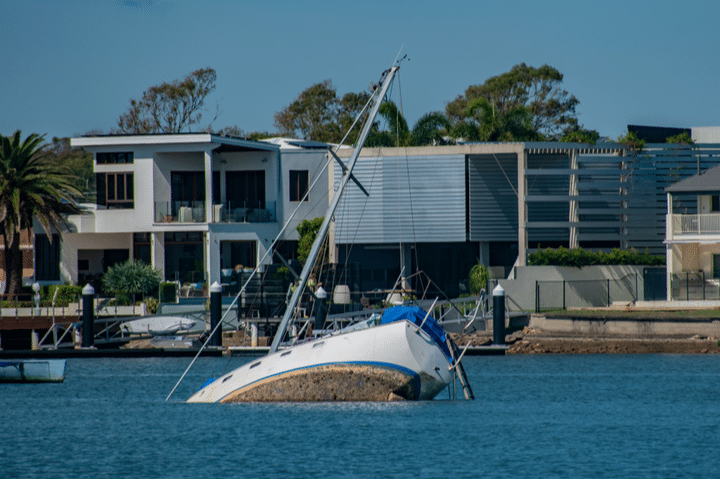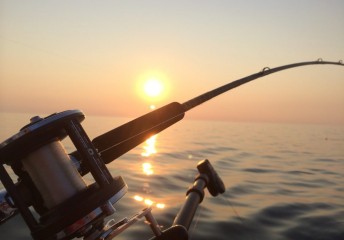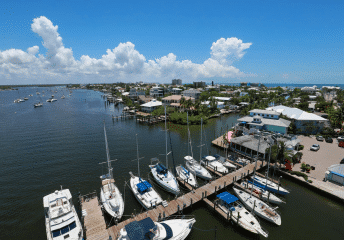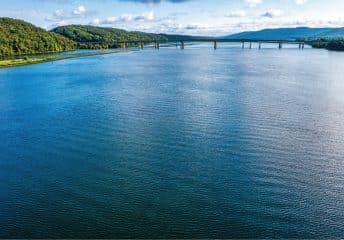What Should You Do If Your Boat Capsizes
Last Updated on February 24, 2022 by Boatsetter Team
It doesn’t occur often, but sometimes the worst happens when you are out on the water, and your boat capsizes, putting you and your passengers at a safety risk. If emergency situations occur, it is key that you are prepared for them beforehand. Then, when an emergency occurs, you should know what to do as a result of knowing what steps to take in advance.
In this article, we cover everything concerning the hypothetical situation that your boat capsizes so that you and your crew can be prepared.
What Causes a Boat to Capsize?
A capsize is defined as a boat rolling over onto its side or completely over. Boats capsize because they become unstable. There are three main reasons for that instability: too much or unbalanced crew and equipment weight; leaking water, which also creates too much weight; and bad weather, which causes instability as the boat is rocked and filled with water.
What Boats are at a Risk to Capsize and Why?
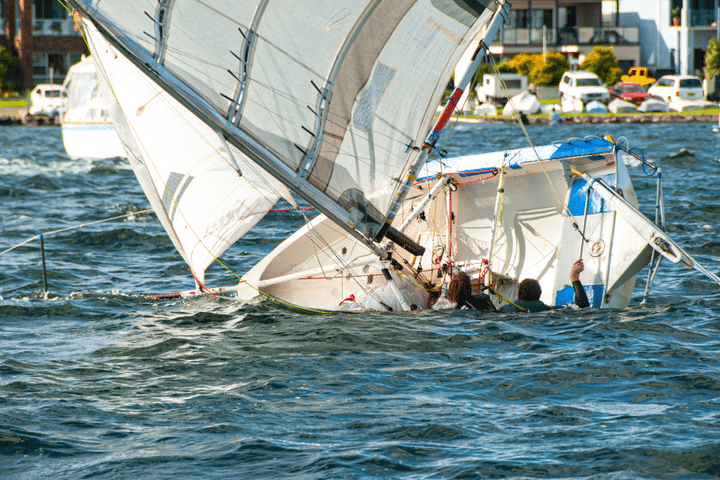
The majority of capsizes are smaller boats. About 10 percent of capsizes are 8-footers, mostly dinghies, and these capsize often don’t cause very much damage. The biggest group by far consists of 15-19 footers, representing 41 percent of all capsizes. These boats are typically fishing boats, often with large, hard-to-drain cockpits, sometimes out in poor weather, and sometimes overloaded. The next most common group are boats in the 20-24 foot range, representing 25 percent of all capsizes; finally are the largest boats, those over 25 feet, representing 18 percent of all capsizes.
Poor Weight Distribution
The most common cause of boat capsizing is poorly distributed weight. The 15-19 footers are the most susceptible to the main cause of capsizing, which is poorly distributed weight, such as an extra person or two or a couple of heavy coolers aboard. Older boats especially may have gained weight over the years as more gear is stored aboard. On boats with cockpit drains, a large friend or a second cooler may be all it takes to make the water come back through the drains, filling the boat. While most of these under 20-foot boats must have floatation, they must also have a capacity plate that states how much weight and how many people can be safely on board.
It’s important to pay attention to this number and keep in mind that the number of seats in a boat is not always an indication of the number of people a boat can safely carry. Exceeding the capacity limits, even in calm water, can put you at a much higher risk of capsizing. All it may take is a stiff wind, a large wake, or an unbalanced load to lead the boat to flop over. Additionally, where the weight is distributed is almost as important as the amount. Too many people on one side of the boat forces the gunwale too far down, potentially allowing water to pour in. For this reason, boat manufacturers often proved a diagram for each boat showing where passengers can safely sit, not to upset the boat’s balance.
Some boat manufacturers label upper decks on their larger boats to indicate how many passengers can be on upper decks. The weight that is substantially above the waterline raises the boat’s center of gravity and makes the boat less stable and more likely to capsize. Another thing to keep in mind is that people have gotten larger over the years.
The Center for Disease Control (CDC) says that the average weight of an individual in the United States has increased to 185 pounds, up significantly since commercial passenger-carrying regulations went into effect in the 1960s when the average American weighed 160 pounds. As you can imagine, those extra pounds can add up, especially on larger boats that are capable of carrying many passengers, causing your boat to be unbalanced. While it may not be your initial impulse to do so, it’s a good practice to eyeball your guests and try and get a ballpark estimate of weight before you take out a larger group.
The bottom line is that loading too much cargo or too many passengers in one part of the boat can affect the boat’s stability, even when the total load is within the boat’s maximum capacity. Additionally, weight needs to be evenly distributed, especially on a small boat.
Leaks
The second major cause of capsizing is leaks. Sometimes it’s as simple as forgetting to put in the drain plug; other times, it’s leaking fittings. Water sloshing around in the bottom of the boat affects stability, allowing for waves or a wake to cause the boat to flip. Tying the drain plug to your boat is a simple way to remember the plug. On the other hand, leaking fittings that can fill the boat with water are usually out of sight, often in livewells and bait boxes. Any fitting that penetrates the hull needs to be closed and made from stainless steel, bronze, or marelon.
Many older boats have low transom cutouts that can cause the boat to flood simply by slowing down too quickly, especially with excess weight in the stern. Newer outboard boats have a well that reduces this particular risk.
Some boats have cockpits that drain into the bilge, requiring the use of a bilge pump even to stay afloat. Bilge pumps are designed to remove nuisance water only, not to keep a boat from sinking. One must be cautious if your boat’s cockpit drains into the bilge because if the bilge pump fails, your boat can fill with water and capsize or sink.
Bad Weather
The third major cause of a capsized vessel is bad weather, which often acts in concert with some of the factors spoken of above, such as overloading or unbalanced loads, to cause a boat to capsize. Small boats are easily overwhelmed by modest waves or even a large wake, especially if they have a large load and sit low in the water. A sudden squall can flip even larger boats. Therefore, it is important to check the weather forecast before going out and keeping an eye on the sky.
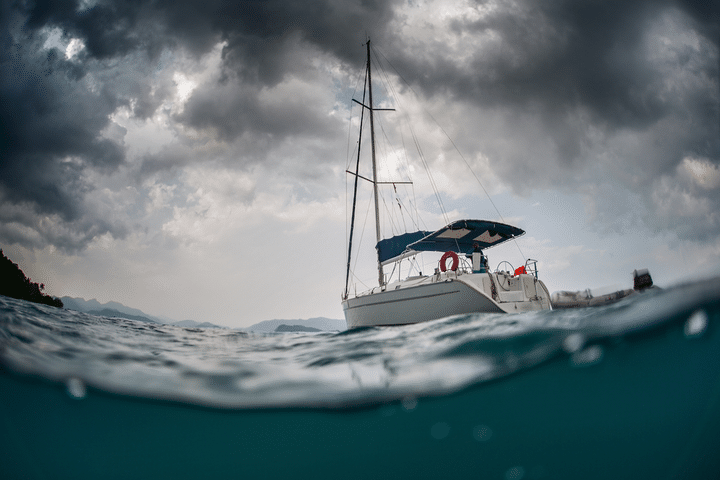
In most areas, NOAA broadcasts continuous weather via radio. If you are in a cellular data range, smartphone apps can show you detailed weather maps, including radar, indicating approaching storms. Since weather changes quickly on the water, you need to head back to the dock at the first sign of bad weather. If you do happen to be caught in a storm, you and your passengers should stay low near the boat’s center to maintain stability.
How to Proceed if Your Boat Does Capsize
Now that we have gone over the risks of capsizing that each boat faces and how you can avoid these risks, it’s still important to know what to do if your boat capsizes.
The first thing you should do when a vessel capsizes is, check the people onboard and make sure that no one is injured.
If you made the mistake of not wearing a lifejacket or a PFD, find one and put it on. If you can’t put it on, hold onto it and have the other passengers do the same.
Next, do a headcount of those who were on board.
The most important thing you can do is stay with your boat if it remains floating. This exponentially increases your chances of being rescued by fellow boaters or the coast guard rescue crews. It’s a lot easier for someone flying over in a helicopter, for example, to find an inverted hull in the water than people floating in the vast sea.
Another recommendation is to retrieve as many supplies as possible from the capsized boat, such as flares, distress signals, and extra flotation devices. Find anything that floats and tether it to the boat to create a bigger target for people searching for you. Another strategy is to release some items into the water to create a debris field which also helps spotters.
If the boat is still floating, try to climb onto the hull to reduce exposure to the water. Water steals body heat 25 times faster than air does. To stay warm and stave off hypothermia, you and the other passengers need to huddle together to pool warmth.
It’s important to remember that if you are more than 100M from shore, don’t try and swim to shore. It is safer to stay with your party and the boat and wait to be rescued.
Conclusion:
It’s easy to feel that you are invincible when you are out on the water in your boat of choice. Still, the fact is that it is important to keep an eye on the safety of you and your passengers, especially when it comes to the possibility of capsizing. Too much weight or unbalanced weight can severely affect your boat’s stability. Leaks can also be a large contributing factor to capsizing. And finally, one must always be wary of the weather when going out on a boat.
In case of disaster, It is important to follow the procedures listed above, such as putting on life jackets, staying with the boat, and salvaging all life jackets and floatation devices from the boat to increase your visibility. By following these procedures, you increase your and your passenger’s chances of a safe rescue.

Boatsetter empowers people to explore with confidence by showing them a world of possibility on the water. Rent a boat, list your boat, or become a Boatsetter captain today.
